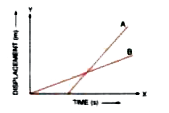A vehicle moving on a straight road has ....................... (rectilinear/curvilinear) motion.
To solve the question, "A vehicle moving on a straight road has ....................... (rectilinear/curvilinear) motion," we need to understand the definitions of the two types of motion provided: rectilinear motion and curvilinear motion.
1. Understand the Definitions:
- Rectilinear Motion: This refers to the motion of an object along a straight line. If an object moves in a straight path without changing its direction, it is said to be in rectilinear motion.
- Curvilinear Motion: This refers to the motion of an object along a curved path. If an object moves in a curve or changes its direction continuously, it is said to be in curvilinear motion.
2. Analyze the Given Situation:
- The question states that a vehicle is moving on a straight road. This implies that the path taken by the vehicle does not change direction and remains straight.
3. Determine the Type of Motion:
- Since the vehicle is moving along a straight road, it is not changing its direction. Therefore, the motion of the vehicle is in a straight line.
4. Fill in the Blank:
- Based on the definitions and the analysis, we can conclude that the correct term to fill in the blank is "rectilinear."
5. Final Answer:
- A vehicle moving on a straight road has rectilinear motion.
- Rectilinear Motion: This refers to the motion of an object along a straight line. If an object moves in a straight path without changing its direction, it is said to be in rectilinear motion.
- Curvilinear Motion: This refers to the motion of an object along a curved path. If an object moves in a curve or changes its direction continuously, it is said to be in curvilinear motion.
- The question states that a vehicle is moving on a straight road. This implies that the path taken by the vehicle does not change direction and remains straight.
- Since the vehicle is moving along a straight road, it is not changing its direction. Therefore, the motion of the vehicle is in a straight line.
- Based on the definitions and the analysis, we can conclude that the correct term to fill in the blank is "rectilinear."
- A vehicle moving on a straight road has rectilinear motion.
Topper's Solved these Questions
- FORCE AND PRESSURE : MOTION BOOK - ICSECHAPTER - FORCE AND PRESSURE : MOTION EXERCISE - QUESTIONS (Write T for True and F for False. Correct the false statements.)
5 Videos
- FORCE AND PRESSURE : MOTION BOOK - ICSECHAPTER - FORCE AND PRESSURE : MOTION EXERCISE - EXERCISES (SECTION I)
15 Videos
- ENERGYBOOK - ICSECHAPTER - ENERGYEXERCISE - EXERCISE (PICTURE STUDY)
3 Videos
- HEATBOOK - ICSECHAPTER - HEATEXERCISE - EXERCISE (PICTURE)
10 Videos
Similar Questions
Knowledge Check
A car moving on a straight road is an example of:
Arotatory motionBrectilinear motionCoscillatory motionDperiodic motion
A vehicle moving in a straight road has its speed changed from 5 m/s to 8 m/s in 2 sec. What is its average acceleration ?
View SolutionA vehicle is moving on a rough road in a straight line with uniform velocity
View SolutionFig. 2.33 shows displacement-time graph of two vehicles A and B moving along a straight road. Which vehicle is moving faster ? Give reason.

View SolutionThe velocity of a car moving on a straight road increases linearly accroding to equation, v=1+bx , where a&b are positive constants. The acceleration in the course of such motion :(x is the displacement )
View SolutionA particle moving in a straight line has its velocit varying with time according to relation v=t2−6t+8(m/s) where t is in seconds. The CORRECT statement(s) about motion of this particle is/are:-
View SolutionMoving blades of windmill has ………………… (rotatory/curvilinear) motion.
View SolutionAn airplane is observed by two observers traveling at 60kmh−1 in two vehicles moving in opposite directions on a straight road. To an observer in one vehicle, the plane appears to cross the road track at right angles while to the other appears to be 45∘. At what angle does the plane actually cross the road track and what is its speed relative to ground ?
View Solution
